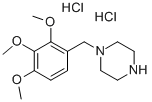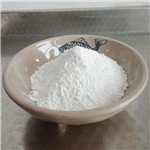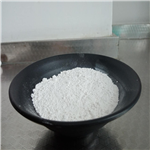Description
Trimetazidine dihydrochloride is the dihydrochloride salt of Trimetazidine. It is a drug used for the treatment of angina pectoris. It is capable of improving the left ventricular function in diabetic patients suffering coronary heart disease as well as treating the symptoms of patients suffering heart failure of different etiologies. It takes effects through acting as an anti- ischemic metabolic agent being capable of improving the utilization efficiency of myocardial glucose by inhibiting the metabolism of fatty acid (through inhibiting the activity of mitochondrial long- chain 3-ketoacyl coenzyme A Thiolase). The shift from fatty acid oxidation to glucose oxidation optimizes cellular energy process in cells exposed to hypoxia or ischaemia, further maintaining the intracellular ATP levels and ensuring the normal function of ionic pumps and transmembrane sodium-potassium flow to maintain cellular homeostasis.
References
Fragasso, G, et al. "A randomized clinical trial of trimetazidine, a partial free fatty acid oxidation inhibitor, in patients with heart failure. " Journal of the American College of Cardiology 48.5 (2006):992.
Tuunanen, H, et al. "Trimetazidine, a metabolic modulator, has cardiac and extracardiac benefits in idiopathic dilated cardiomyopathy."Circulation 118.12(2008):1250.
Kantor, P. F., et al. "The antianginal drug trimetazidine shifts cardiac energy metabolism from fatty acid oxidation to glucose oxidation by inhibiting mitochondrial long-chain 3-ketoacyl coenzyme A thiolase."Circulation Research 86.5(2000):580.
Stanley, W. C., and M. Marzilli. "Metabolic therapy in the treatment of ischaemic heart disease: the pharmacology of trimetazidine. "Fundamental & Clinical Pharmacology 17.2(2003):133–145.
Kantor, Paul F., et al. "The antianginal drug trimetazidine shifts cardiac energy metabolism from fatty acid oxidation to glucose oxidation by inhibiting mitochondrial long-chain 3-ketoacyl coenzyme A thiolase." Circulation research 86.5 (2000): 580-588.
Description
Trimetazidine (hydrochloride) (Item No. 18165) is an analytical reference standard that is structurally categorized as a piperazine. It decreases fatty acid β-oxidation by reversibly inhibiting mitochondrial long-chain 3-ketoacyl thiolase (IC
50 = 75 nM). This, in turn, stimulates glucose oxidation. In ischemic heart, trimetazidine reduces ischemia/reperfusion injury in clinical trials. Compounds that reduce mitochondrial fatty acid β-oxidation, including trimetazidine, have shown clinical efficacy against chronic stable angina in clinical trials. In part because of its ability to ameliorate testosterone cardiotoxicity, trimetazidine has been classified as a prohibited substance by the World Anti-Doping Agency. This product is intended for research and forensic applications.
Uses
1-(2,3,4-Trimethoxybenzyl)piperazine dihydrochloride or trimetazidine dihydrochloride can be used as a building block to synthesize:
- Phenylpropyl trimetazidine derivatives with potent cerebral vasodilator activity.
- Benzoylguanidine-trimetazidine derivatives for myocardial ischemic-reperfusion activity studies.




